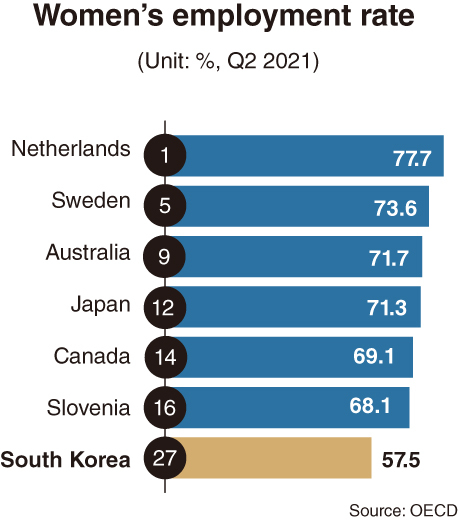Korea, 27th of 33 OECD members in women’s employment
As for men, Korea ranks 18th, Japan 1st in Q2
SEJONG South Korea was one of seven countries whose employment rate for women stayed under 60 percent as of June, among 33 members of the Organization for Economic Cooperation and Development.
As for the employment rate for men, Korea also fell far behind its Asia-Pacific neighbors such as Japan, which topped the list, and New Zealand as well as some emerging economies.
According to the OECD, the women’s employment rate in Korea posted 57.5 percent in the second quarter of this year. The figure is calculated as the portion of those employed among the female working-age population, which is 15-64.
This placed the nation at 27th of the 33 surveyed. Of the total 38 OECD members, the Paris-based organization has yet to compile or make public the relevant figures of five members Denmark, Greece, Ireland, Luxembourg and Turkey.
 |
|
|
Korea lagged far behind neighbors in the Asia-Pacific region: 71.3 percent was reported for women in Japan (12th), 71.7 percent in Australia (ninth) and 73.5 percent in New Zealand (sixth).
Among emerging economies, Estonia placed No. 13 with 70.4 percent, Latvia (15th) was at 68.3, Slovenia (16th) hit 68.1 percent, Hungary (17th) had 67.8 percent, the Czech Republic (20th) marked 66.3 percent and Slovakia (21st) sat at 65 percent.
The top 10 in the female employment ranking included the Netherlands (No. 1 at 77.7 percent), Iceland, Norway, Switzerland, Sweden, Germany, the UK and Finland.
While the average of Group of 7 countries reached 65.9 percent, 69.1 percent was seen in Canada, along with 64.2 percent in the US and 64.1 percent in France. The OECD average has yet to be publicized.
As for men’s employment rate in the OECD analysis, Korea ranked 18th among the 33 members with 75.1 percent in the corresponding second quarter.
This contrasted with 84 percent in Japan (No. 1), 81.9 percent in New Zealand (fifth), 81.1 percent in the Czech Republic (sixth) and 79 percent in Australia (eighth).
Hungary ranked 10th at 78 percent, Mexico (12th) at 77.3 percent and Poland (14th) at 76.6 percent in the male employment rate.
Meanwhile, local data shows the serious situation of Korea’s hiring market, in which the proportion of nonregular jobs such as of temporary workers and part-timers has continued to increase.
According to Statistics Korea, 45 percent of all women workers in the nation were in nonregular job positions as of August 2020 4.09 million of 9.08 million employed women.
The percentage posted its highest number since the nation started compiling the relevant data in 2003. While it was tied with 45 percent in 2019, the previous high was 44 percent, posted in August 2009, when the nation was hit by the global financial crisis.
The figure for nonregular jobs among employed women ranged between 39.9 percent and 41.1 percent during the previous Park Geun-hye administration (2013-2017). After inching up to 41.2 percent in August 2017 under the Moon Jae-in administration, and to 41.5 percent in 2018, it surged to 45 percent in 2019 and 2020.
As for men, the tally for nonregular jobs reached 3.33 million of the total 11.36 million male workers, or 29.4 percent. Like women, the figure for men tied with that of 2019. Both the 2019 and 2020 figures were the second-highest in history after 30.6 percent in 2008.
Some government officials argued that the rapid growth between 2017 and 2019 in the number of nonregular jobs is due to the reclassification of some regular workers, totaling about 350,000-500,000 as nonregular workers in 2019.
They highlighted “a new standard” set by the Switzerland-based International Labor Organization.
But this, even if true, is hard to justify as nonregular jobs increased by 900,000 in the 2017-19 period, one labor researcher said.